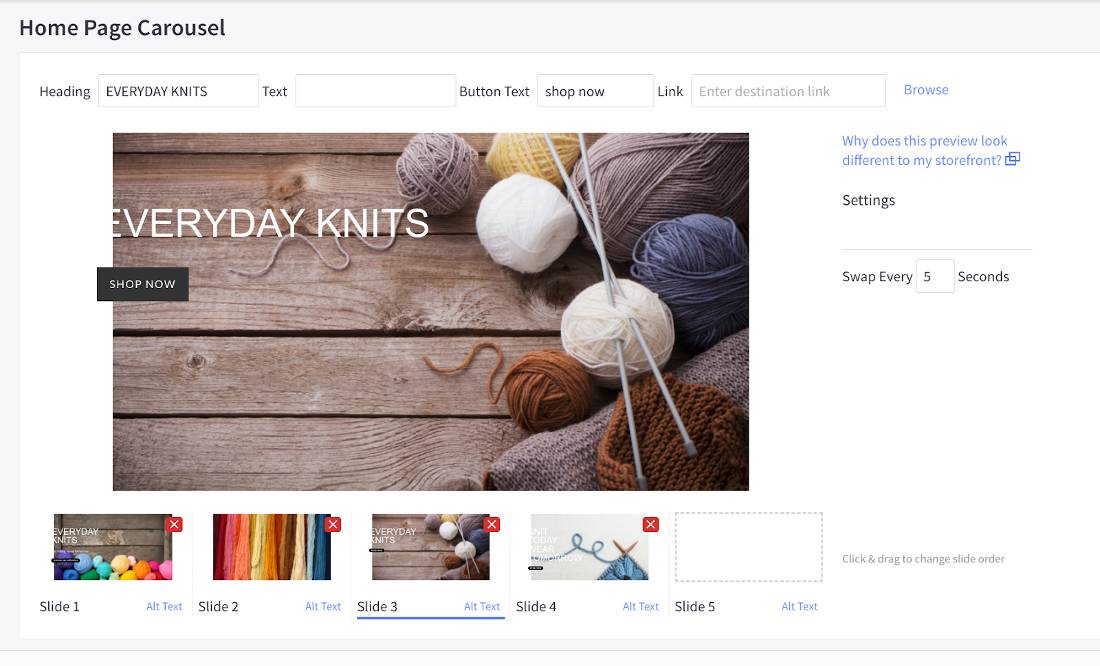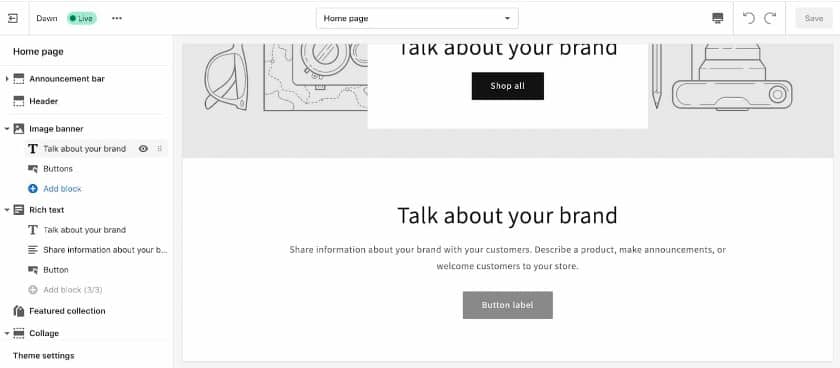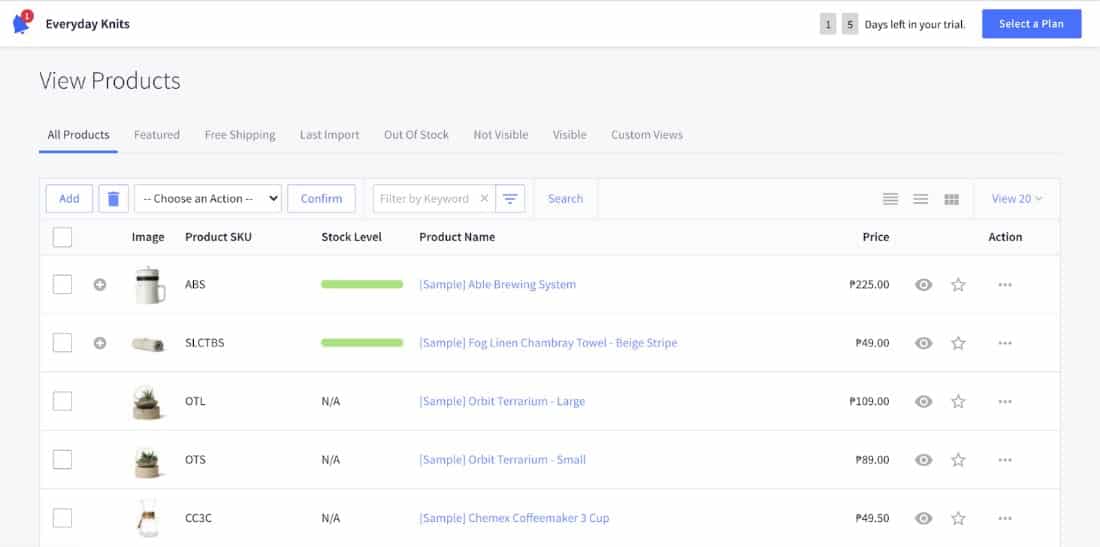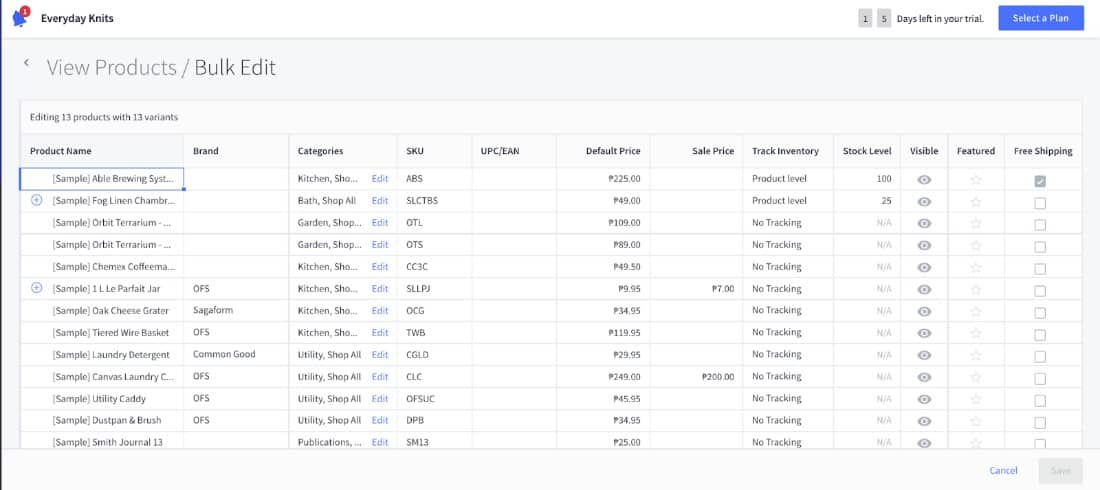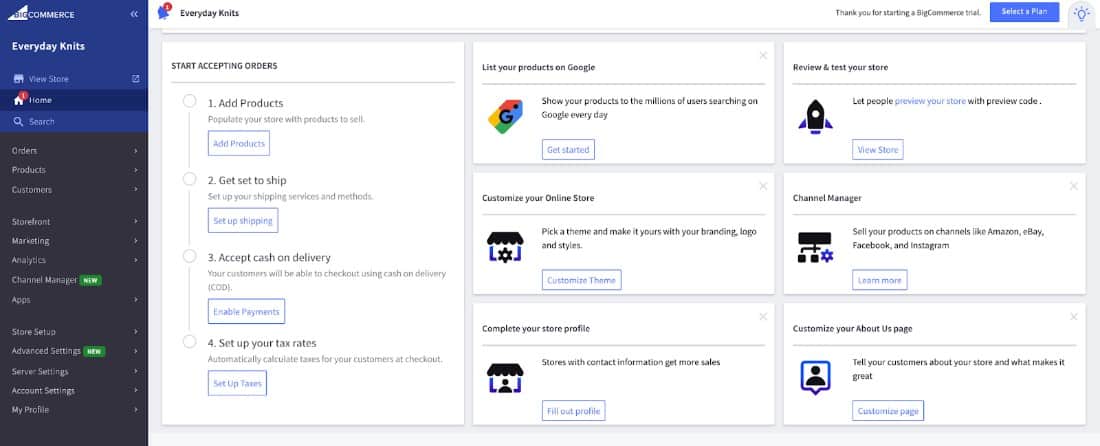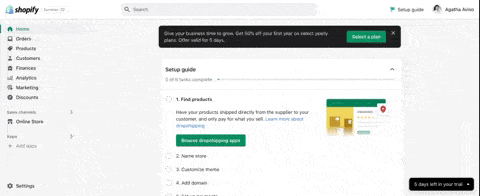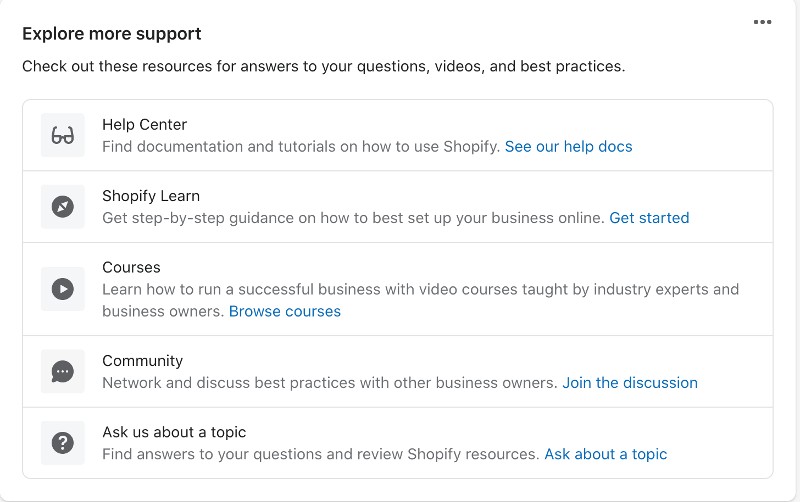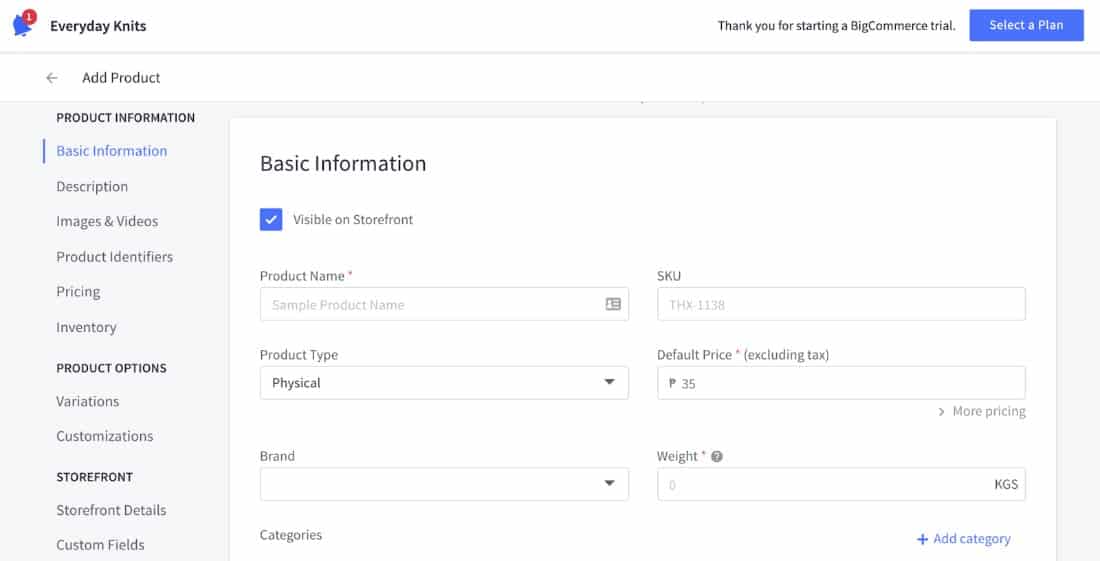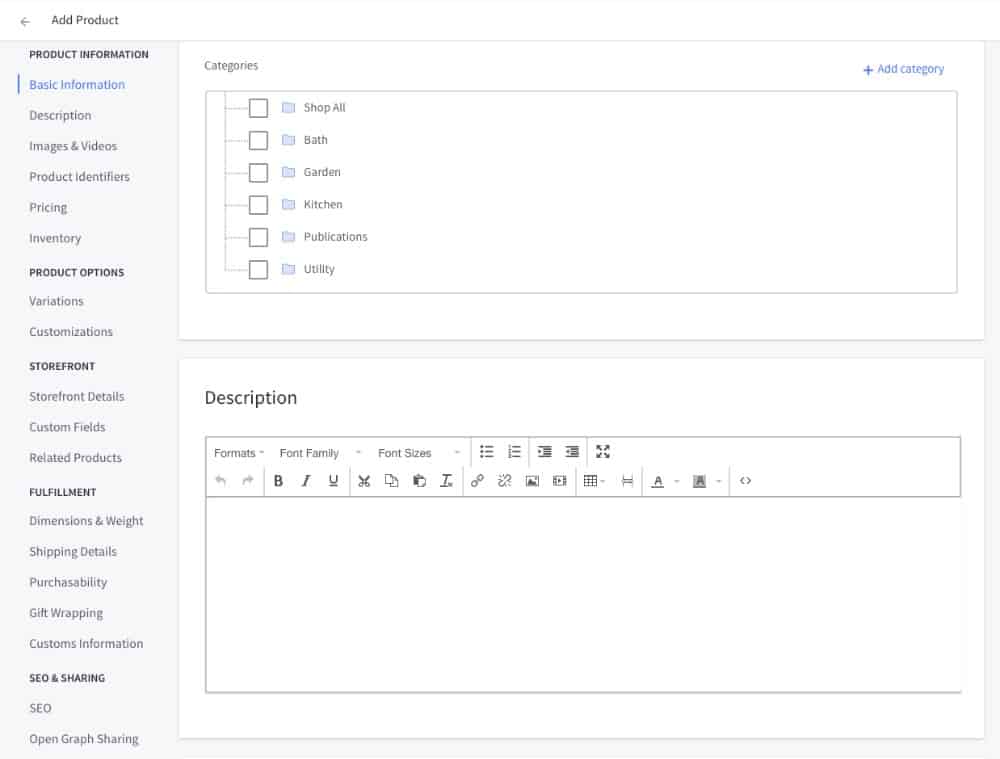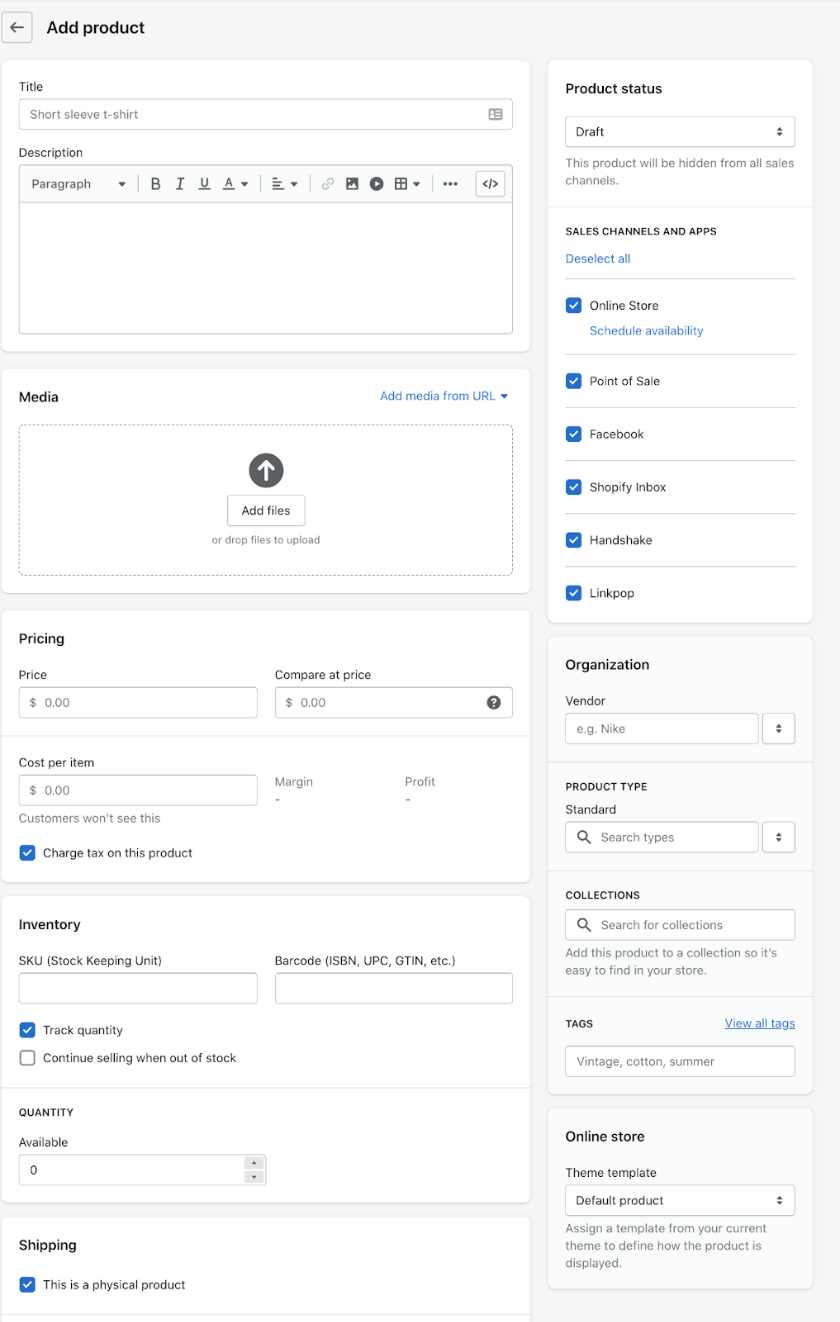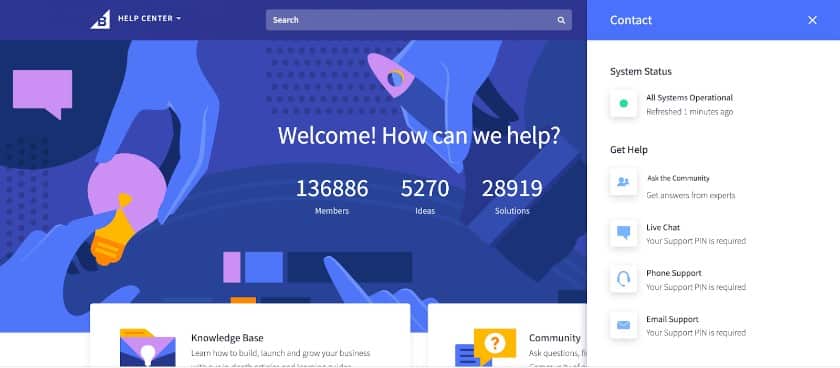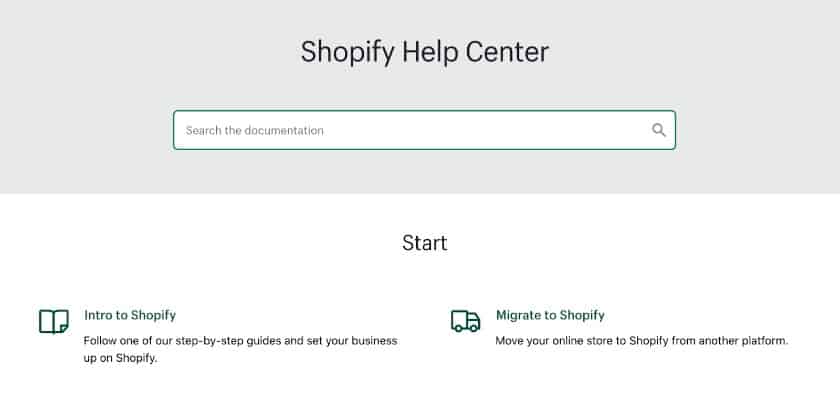BigCommerce and Shopify are highly rated by our experts. Read about how they compare below.
BigCommerce vs Shopify: Price, Features & What’s Best
This article is part of a larger series on Retail Management.
When it comes to BigCommerce vs Shopify, the choice of which ecommerce platform to go with will depend on your business needs and priorities.
Shopify has the edge in payment processing, app marketplace, ease of use, and marketing, making it best for most small businesses.
BigCommerce has the best product and order management tools and allows you to connect your payment processor of choice with no added transaction fees, making it best for growing businesses or those with complex product assortments.
Comparing Shopify vs BigCommerce boils down to:
- Best for small businesses or startups: Shopify
- Best for enterprise-level or high-revenue businesses: BigCommerce
To evaluate the two, we looked at price, website tools, marketing features, and ease of use. We also tested both platforms by building the same demo store on each.
Shopify vs BigCommerce: Quick Comparison
4.65 out of 5 | 4.52 out of 5 | |
Best For | Small businesses or startups | Enterprise-level or high-revenue businesses |
Monthly Fees | Starts at $39; Shopify Starter plan available ($5) | Starts at $39 |
Additional Sales Channels | Facebook, Instagram, TikTok, Etsy, and more | Facebook, Instagram, TikTok, Google, Walmart, Amazon, and more |
Ease of Use | Excellent | Average |
POS App | Yes; free and paid options | N/A; can be integrated with POS platforms |
Marketing Features | Excellent | Excellent |
Product and Order Management | Average | Excellent |
App Marketplace | Excellent | Average |
Customer Support | 24/7 email, live chat, and phone | 24/7 email, live chat, and phone |
When to Use Each
Get a Personalized Recommendation
Are you still undecided about which ecommerce platform to use? Take our quiz below for a personalized recommendation. You won’t need to enter personal information or be directed to another page.
BigCommerce vs Shopify: Pricing & Payments
4 out of 5 | 3.75 out of 5 | |
Subscription Monthly Plans | $39–$399/month | $39–$399/month |
Subscription Annual Fees | $29–$299/month (25% discount) | $29–$299/month (25% discount) |
Starter Plans (Sell on social channels) | N/A | $5/month |
Free Trial | 15 days | 3 days, then $1/month for three months |
Built-in Payment Provider (Optional) | PayPal powered by Braintree (special discounted rates) | |
Option to Connect to Third-Party Processor | Yes; no fees or markups | Yes; 0.5% to 2% fee |
Payment Gateway Options | 65-plus | 100-plus |
Financing Options (Buy Now, Pay Later Options) | None, but third-party integration is available | Yes, Shop Pay (built-in) and third-party apps |
Our Expert Take:
BigCommerce edged out Shopify in this category because it offers a longer free trial, a more robust first-tier subscription plan, and zero transaction fees on third-party payment processing. However, both platforms provide three-tiered pricing structures and custom plans for enterprise businesses that are remarkably similar.
Let’s unpack both platforms’ basic plans, Shopify’s Basic Shopify and BigCommerce’s Standard. Both are priced at $39 per month, but BigCommerce’s Standard provides more robust features, specifically:
- Professional reporting features
- Built-in ratings and review system
- Automatic currency conversion, based on geolocation
- Real-time carrier shipping quotes from third-party carriers
- The ability to create and manage up to three storefronts
However, Shopify’s Basic Shopify has these advantages:
- No sales limits, compared to a $50,000-per-year sales limit on BigCommerce’s Standard
- Abandoned cart recovery on its entry-level plan; BigCommerce only offers it starting on its Plus plan at $105 per month
BigCommerce has three subscription plans with the following monthly fees: Standard ($39), Plus ($105), and Pro ($399). Enterprise packages are also available and done via custom quote for those who exceed $400,000 in annual online sales revenue.
- Standard ($39/month): Signing up for the Standard plan gives you real-time shipping quotes, professional reporting tools, coupons, discounts, and gift cards, and the ability to manage up to three storefront. Your store also has a $50,000 annual online sales limit.
- Plus ($105/month): This tier includes all Standard features, plus an abandoned cart saver, persistent cart saver, customer groups, stored credit cards, and up to five storefronts. Your sales limit also more than triples—$180,000.
- Pro ($399/month): The plan provides product filtering, custom SSL (Secure Sockets Layer), and Google customer reviews, up to eight storefronts—in addition to all the features mentioned in Plus. $400,000 is your annual online sales limit for this plan.
Shopify has three subscription plans with the following monthly fees: Basic Shopify($39/month), Shopify ($105/month), and Advanced Shopify ($299/month). An enterprise plan is also available by request (custom quote).
- Basic Shopify ($39/month): You access Shopify’s core features—build an online store and sell unlimited products throughout virtually any selling channel on the internet.
- Shopify ($105/month): Under the Shopify plan, you access tools like professional-level reporting, POS enhancements such as register shifts and unlimited staff PINs for tracking activities.
- Advanced Shopify ($399/month): When your business takes off like a rocket, you’ll need every ecommerce tool Shopify has in its arsenal. Advanced Shopify is where you find that. In addition to everything mentioned above, this pricing tier gives you an advanced report builder, calculated third-party shipping rates, and a discount on Shopify credit card payment rates.
It also offers a much lower tier at $5/month, the Shopify Starter plan, which allows you to embed Buy Now buttons to existing website pages and generate checkout links for social channels. Note, though, that under this plan, you will not be able to build a standalone store.
Calculate fees and find the best plan for you with our Shopify pricing guide.
Both have built-in payment processing—Shopify Payments (Shopify) and PayPal, powered by Braintree (BigCommerce)—but you have the option to go with a different payment provider.
However, BigCommerce’s most significant advantage over Shopify is the lack of transaction fees for connecting a third-party processor. Shopify charges transaction fees (0.5%–2%) on top of the usual credit card processing fees when you use a different payment provider.
Rather than bundling its payment processor, BigCommerce allows you to pick the payment gateway right for you. So, larger businesses that process many transactions can shop around for the lowest rates.
Shopify led the one-click checkout innovation with Shop Pay (its one-click checkout solution). You can activate the feature even without using Shopify Payments. Shop Pay is currently available to use with Shopify Payments, third-party payment processors, and Facebook and Instagram Shops.
Meanwhile, BigCommerce’s one-click checkout option is Bolt—an obvious answer to Shopify’s Shop Pay. It is a native integration to BigCommerce, making it easier to activate from your dashboard. However, it is a paid add-on, starting at $19.99 a month.
Interested to know the true cost of starting an online store with BigCommerce and Shopify? When we tested the two platforms and built demo stores, we compiled our estimated expenses and found the following:
- BigCommerce: We roughly estimate startup expenses to range between $350 to $700, with monthly expenses ranging from $105 to $300. We pegged it to be slightly higher than Shopify because BigCommerce’s built-in marketing tools will be a lifesaver for your online store when you are just starting out, and BigCommerce’s abandoned cart saver feature is on the $105/month plan.
- Shopify: For startup fees, expect to pay $300 to $600 initially and around $75 to $150 in monthly expenses at the onset, including add-ons. If you need to sell in-store, that will be an additional $49 to $499 for hardware purchases plus an $89 per location monthly fee for using Shopify POS Pro (which we recommend).
BigCommerce vs Shopify: Site Builder & Maintenance
4.38 out of 5 | 4.5 out of 5 | |
Free Templates | 12 | 11 |
Paid Templates | 100-plus (starting at $150) | 110-plus (starting at $180) |
Editing Tool | Drag-and-drop builder | Drag-and-drop builder |
Customization | Yes (CSS and HTML) | Yes (CSS and HTML) |
App Marketplace / Add-ons | Extensive (1,000+) | Extensive (8,000+) |
SSL Certificates | Free and paid ($59 to $299) | Free |
PCI-Compliant | Yes | Yes |
Our Expert Take:
It was a close fight, but Shopify slightly wins over BigCommerce in this criteria because of its easier-to-use site builder and very extensive third-party integrations—more than 8,000 compared to BigCommerce’s 1,000-plus. If there’s something your store needs, it’s a near certainty that you’ll find it in Shopify’s app store.
If you want to know how we tested and built our demo stores, you can follow along the guides below:
Both platforms offer free and paid mobile-first themes. Shopify offers slightly more templates than BigCommerce, but what makes its themes better is that they are very diverse to begin with, so you won’t have to tweak as much. While BigCommerce provides a selection of free and paid themes, the most common feedback about BigCommerce themes, especially its free ones, is that they differ only in color.
When it comes to website builders, both have drag-and-drop editors with interfaces that help you easily edit and see changes in real time. BigCommerce’s site builder is called Store Design, and Shopify’s is called Online Store 2.0 (OS 2.0).
When we created our demo stores, we found it easier to build page sections using Shopify’s building clocks. BigCommerce provided a similar interface, but we realized it all boiled down to having a great-looking theme to begin with.
It was easier to visualize and have everything come together with Shopify’s default free theme, Dawn. BigCommerce’s free one, Cornerstone, had a dated design, and we had difficulty adjusting text over carousel images. If you decide to go with BigCommerce, we recommend going with a paid theme.
If you are ready to invest or have a web developer to build your site, BigCommerce now offers headless commerce solutions and has partnerships with Bloomreach, Sitecore, Adobe Experience Manager, and Drupal.
Both platforms provide the basic SEO toolkit—metadata customization, image alt tags, mobile optimization, 301 redirects, and blogging features.
BigCommerce provides more advanced SEO features with the ability to access sitemaps, structured data, and keyword support. However, what Shopify lacks in SEO features, it provides as add-on options from its App Store. Chances are it will have what you need—it has close to 600 SEO apps in the App Store.
Both are fully hosted platforms, so they have free SSL certificates on all their plans and are Payment Card Industry Data Security Standard (PCI DSS)-compliant. The only difference between the two platforms is that you cannot install a third-party SSL certificate on Shopify. With BigCommerce, those who are under the Pro and Enterprise plans can upgrade to a more advanced SSL certificate with site seals and warranties. BigCommerce offers GeoTrust security certificates, ranging from $59 to $299.
BigCommerce has more than a thousand apps on its app store—which is already great compared to other ecommerce platforms. However, it is no match to Shopify’s more than 8,000 apps—from dropshipping to email marketing to customer segmentation. It is the biggest and most extensive app store among the ecommerce platforms we have tried.
BigCommerce vs Shopify: Sales & Product Features
Our Expert Take:
As powerful ecommerce platforms, both Shopify and BigCommerce know the importance of marketing for online stores, and they provide excellent tools to help get your site noticed. However, Shopify earned a perfect score in this category because of its built-in POS tool, robust marketing tools (present across all subscription levels), and extensive add-on availability in the Shopify app store. Building an online store with Shopify has limitless potential—it is the only ecommerce platform that scored perfect marks in this criteria.
Arguably, Shopify’s most considerable advantage over BigCommerce is its proprietary POS app. The POS app allows you to start taking payments immediately, without the hassle of setting up a third-party solution. Shopify sells several very convenient credit card scanners if you’re selling in person. However, you are not locked into using Shopify’s payment system, and the service is compatible with most third-party solutions also offered by BigCommerce.
BigCommerce doesn’t have a built-in POS system, unlike Shopify. Still, it provides numerous integrations to popular POS systems like Vend, Square, and Clover.
When it comes to multichannel selling, neither platform limits your sales to your online storefront, enabling you to sell on popular sales platforms such as Facebook, Amazon, eBay, and Instagram. Shopify has industry-leading partnerships with social channels like Facebook, Instagram, and TikTok. If you want the ability to offer in-app social media sales, Shopify is for you.
BigCommerce’s edge over Shopify in multichannel sales is that BigCommerce also allows you to sell on enterprise and ecommerce apps—including Google Shopping, Walmart Marketplace, and PriceGrabber—on top of social channels. If these marketplace channels are more important to you than social channels, BigCommerce is your best option.
BigCommerce beats Shopify in product management as it lets you set up to 250 options per product and up to 600 product variants, compared to Shopify’s three options per product and up to 100 product variants. It can also auto-generate stock-keeping units (SKUs) for all combinations of variants
BigCommerce also has custom work order tools so you can set up customization options, such as engraving, image uploads, and more. Image uploads up to 500 MB are accepted. In Shopify, this can only be done using third-party apps.
However, Shopify’s approach to categorizing products is better because products can be populated automatically based on tags or product descriptions (smart collection).
Both platforms provide marketing tools such as coupon codes and discounts you can generate for customers to use in your store. However, Shopify outperforms BigCommerce in every marketing feature—for example, the abandoned cart saver is available across all plans and it has native lead generation and email marketing tools (Shopify Forms and Shopify Email).
BigCommerce’s abandoned cart saver feature claims to recover up to 15% of lost sales and lets you send up to three automated follow-up emails compared to Shopify’s single email. However, the feature is available across all Shopify plans―starting at the $39 plan―whereas BigCommerce unlocks this feature at the $105 tier. It is also worth mentioning that if you are subscribed to Shopify’s higher tiers (Shopify and Advanced Shopify), you can automate a workflow for this using multiple emails through Shopify Flow.
Shopify Forms is a customizable email capture tool designed to work seamlessly with the rest of Shopify. Its native email marketing tool, Shopify Email, lets you send 10,000 free emails each month. You can customize your email look with templates and schedule their delivery, but advanced email marketing features, such as customer behavior segmentation, are unavailable. All these are free for Shopify users across all plans—you can easily grow and nurture your customer base using these tools.
BigCommerce doesn’t have a built-in email marketing tool yet, but free third-party email marketing integration options, such as Mailchimp, are available.
Shopify has a slight edge over BigCommerce in this area when put side by side, as it has intelligent inventory management tools to automate product categories and a fulfillment network for storing and fulfilling orders. You can even adjust inventory from the mobile app. A complete setup with Shopify POS gives you full visibility to manage products and orders in an omnichannel setting. It is our top recommendation for multichannel POS systems.
Keeping track of your inventory is a snap with Shopify. The “Products” tab gives you an at-a-glance view of the products you have on hand and how many are coming in, and it allows you to take set actions when inventory runs low manually.
Moreover, each item you sell has an easily editable product page where you can input and modify a variety of variants, including descriptions, prices, and shipping.

An example of Shopify’s inventory management system: You can set stock inventory levels per product in the product listing pages or go to the inventory tab from your dashboard. It is easier to see at a glance which stocks are running low and add incoming inventory.
Meanwhile, the “Products” tab on BigCommerce’s main interface gives you instant access to your inventory, add new products, and search your list. You can even import your inventory spreadsheet into the interface. You’ll have a sample product inventory to help you learn when you start—something you don’t get with Shopify.
Both BigCommerce and Shopify allow you to set up a variety of shipping rules, such as:
- Free shipping rates
- Flat rates
- Price-based rates
- Weight-based rates
- Calculated (“real-time”) shipping rates from third-party carriers
BigCommerce, however, wins when it comes to providing customers with third-party real-time shipping rates—making it available on all of its plans.
With Shopify, you’ll need to be on the $299 Advanced Shopify to unlock third-party real-time shipping rates, a feature included in all BigCommerce plans. However, one thing to note is that Shopify can provide real-time shipping quotes and discounts on any plan if you use Shopify Shipping and its partner couriers.
BigCommerce vs Shopify: Ease of Use
4.5 out of 5 | 5 out of 5 | |
Onboarding and Setup | Yes; easy-to-follow setup wizard | Yes; easy-to-follow setup wizard |
Store Management | Not as beginner-friendly; too many customization options | Beginner-friendly |
Online Knowledgebase | Extensive | Extensive |
Community Forum | Yes; active and helpful community members | Yes; active and helpful community members |
Customer Support: Live Chat, Email, and Phone | 24/7 | 24/7 |
Our Expert Take:
When we compared BigCommerce vs Shopify, we found they’re both somewhat accessible to the everyday user. However, Shopify has a significant advantage in that nearly anyone with minimal computer skills can pick it up almost immediately. In terms of customer support, both Shopify and BigCommerce take excellent care of you. If you ever have a problem, each offers 24/7 support through various channels.
BigCommerce vs Shopify: Expert Score
Our Expert Take:
During our evaluation, Shopify and BigCommerce were always neck and neck with their scores. It all boils down to what your business needs are for an ecommerce platform. You will win whatever platform you go with—both are extremely popular ecommerce platforms with excellent user reviews and expert feedback.
Shopify balances simplicity and ease of use by having all the features small businesses need. This—along with sophisticated point-of-sale (POS) apps, an extensive app marketplace, and plans that can grow with your business—make Shopify the best ecommerce platform for most small businesses.
Meanwhile, BigCommerce allows you to shop for the lowest transaction fees from any payment processor. While Shopify has limitations on the number of variants each product can have, BigCommerce does not, making it a better option for growing ecommerce businesses that have complex product assortments or want to save on processing fees.
BigCommerce
Shopify
Methodology—How We Evaluated Shopify vs BigCommerce
BigCommerce vs Shopify Frequently Asked Questions (FAQs)
Both platforms are highly reviewed by users and ecommerce experts alike. In our evaluation of the best ecommerce platforms for small businesses, Shopify came out on top, with BigCommerce coming in a very close second. Shopify edged out BigCommerce in all aspects (site builder, sales and marketing features, and ease of use) except for pricing. BigCommerce offers a more extended free trial period (15 days).
BigCommerce offers a high level of customization for its ecommerce builder so it can be a steep learning curve for those just starting. It also has sales volume limits on its subscription plans.
They are the same in that they are both ecommerce website builders. Shopify is best for multichannel sales, startups, and small businesses, while BigCommerce is better suited for high-revenue and enterprise businesses.
Bottom Line
When choosing between Shopify and BigCommerce, it will come down to what kind of business you have. If you run a large enterprise that requires numerous user accounts, you need BigCommerce. However, Shopify’s easy-to-use nature and Shopify Lite offering make it the clear winner for small businesses, solopreneurs, and budding enterprises.
We recommend Shopify for anyone launching an ecommerce platform for the first (or second and third) online storefront. It’s easy to sell your products as early as the first day of your free trial, so start yours today.



